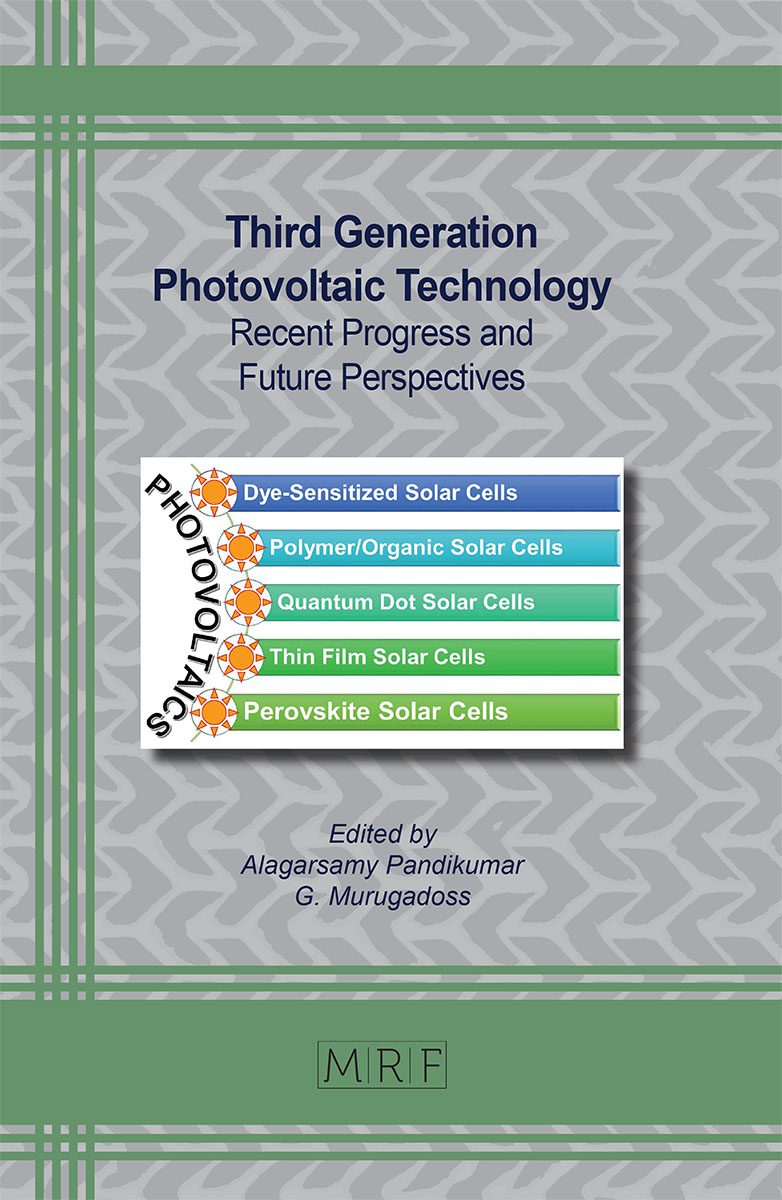Recent Developments in Materials for Dye-Sensitized Solar Cells
Santhosh Narendhiran, Manoj Balachandran
Over the past few years, a variety of photovoltaic devices have been developed to serve a diverse range of applications. These devices include inorganic, organic, and hybrid solar cells. Despite the high conversion efficiency of silicon-based solar cells, their practicality is constrained by the expensive module costs and the intricate manufacturing process involved. Among them, dye-sensitized solar cells have emerging technology to power a portable electronic device and work with both outdoor and indoor light, reducing the energy demand in the present scenario. This chapter explains the working mechanism and components of DSSC materials and provides insights into recent developments.
Keywords
Solar Cells, Light-Sensitive Dye, Energy, Photovoltaic Cells
Published online 3/25/2024, 14 pages
Copyright © 2024 by the author(s)
Published under license by Materials Research Forum LLC., Millersville PA, USA
Citation: Santhosh Narendhiran, Manoj Balachandran, Recent Developments in Materials for Dye-Sensitized Solar Cells, Materials Research Foundations, Vol. 163, pp 38-51, 2024
DOI: https://dx.doi.org/10.21741/9781644903032-2
The article was published as article 2 of the book Third Generation Photovoltaic Technology
References
[1] D. Oteng, Towards a sustainable PV waste policy: Exploring the management practices of end-of-life solar photovoltaic modules in Australia, PhD Thesis, 2023.
[2] M.A. Fazal, S. Rubaiee, Progress of PV cell technology: Feasibility of building materials, cost, performance, and stability, Solar Energy. 258 (2023) 203-219. https://doi.org/10.1016/j.solener.2023.04.066
[3] J. Penman, Performance evaluation of the photovoltaic system, (2023).
[4] F. Rehman, I.H. Syed, S. Khanam, S. Ijaz, H. Mehmood, M. Zubair, Y. Massoud, M.Q. Mehmood, Fourth Generation Solar Cells: A Review, Energy Advances. (2023). https://doi.org/10.1039/D3YA00179B
[5] A. Sharma, V.K. Bajpai, A Review on Development and Technology of Various Types of Solar PV Cell, Optimization Methods for Engineering Problems. (2023) 215. https://doi.org/10.1201/9781003300731-15
[6] B. O’regan, M. Grätzel, A low-cost, high-efficiency solar cell based on dye-sensitized colloidal TiO2 films, Nature. 353 (1991) 737-740. https://doi.org/10.1038/353737a0
[7] J. Gong, J. Liang, K. Sumathy, Review on dye-sensitized solar cells (DSSCs): Fundamental concepts and novel materials, Renewable and Sustainable Energy Reviews. 16 (2012) 5848-5860. https://doi.org/10.1016/j.rser.2012.04.044
[8] J.B. Asbury, E. Hao, Y. Wang, H.N. Ghosh, T. Lian, Ultrafast electron transfer dynamics from molecular adsorbates to semiconductor nanocrystalline thin films, The Journal of Physical Chemistry B. 105 (2001) 4545-4557. https://doi.org/10.1021/jp003485m
[9] V. Sugathan, E. John, K. Sudhakar, Recent improvements in dye sensitized solar cells: A review, Renewable and Sustainable Energy Reviews. 52 (2015) 54-64. https://doi.org/10.1016/j.rser.2015.07.076
[10] J.V. Vaghasiya, K.K. Sonigara, S.S. Soni, Role of metal oxides as photoelectrodes in dye-sensitized solar cells, in: Advances in Metal Oxides and Their Composites for Emerging Applications, Elsevier, 2022: pp. 287-338. https://doi.org/10.1016/B978-0-323-85705-5.00009-9
[11] V. Galstyan, J.M. Macak, T. Djenizian, Anodic TiO2 nanotubes: A promising material for energy conversion and storage, Applied Materials Today. 29 (2022) 101613. https://doi.org/10.1016/j.apmt.2022.101613
[12] A. Gopalraman, J.A. Raj, S. Karuppuchamy, S. Vijayaraghavan, Investigation on the effect of neodymium ion doping in TiO2 on the photovoltaic performance of dye-sensitized solar cells, Materials Chemistry and Physics. 292 (2022) 126785. https://doi.org/10.1016/j.matchemphys.2022.126785
[13] N. Kaur, D.P. Singh, A. Mahajan, Plasmonic engineering of TiO2 photoanodes for dye-sensitized solar cells: a review, Journal of Electronic Materials. 51 (2022) 4188-4206. https://doi.org/10.1007/s11664-022-09707-3
[14] R. Agarwal, S. Sahoo, V.R. Chitturi, J.D. Williams, O. Resto, R.S. Katiyar, Enhanced photovoltaic properties in graphitic carbon nanospheres networked TiO2 nanocomposite based dye sensitized solar cell, Journal of Alloys and Compounds. 641 (2015) 99-105. https://doi.org/10.1016/j.jallcom.2015.03.175
[15] M. Sufyan, U. Mehmood, S. Yasmeen, Y.Q. Gill, M. Sadiq, M. Ali, Metal-Oxide Semiconductor Nanomaterials as Alternative to Carbon Allotropes for Third-Generation Thin-Film Dye-Sensitized Solar Cells, in: Defect Engineering of Carbon Nanostructures, Springer, 2022: pp. 235-268. https://doi.org/10.1007/978-3-030-94375-2_9
[16] K.T. Dembele, G.S. Selopal, C. Soldano, R. Nechache, J.C. Rimada, I. Concina, G. Sberveglieri, F. Rosei, A. Vomiero, Hybrid carbon nanotubes-TiO2 photoanodes for high efficiency dye-sensitized solar cells, The Journal of Physical Chemistry C. 117 (2013) 14510-14517. https://doi.org/10.1021/jp403553t
[17] G. Speranza, W. Liu, L. Minati, Applications of Plasma Technologies to Material Processing, CRC Press, 2019. https://doi.org/10.1201/9780429264658
[18] B.T. Huy, D.H. Kwon, S.-S. Lee, V.-D. Dao, H.B. Truong, Y.-I. Lee, Optical properties of Sr2YF7 material doped with Yb3+, Er3+, and Eu3+ ions for solar cell application, Journal of Alloys and Compounds. 897 (2022) 163189. https://doi.org/10.1016/j.jallcom.2021.163189
[19] N. POOTRAkULCHOTE, Investigation on Functionalized Ruthenium-Based Sensitizers to Enhance Performance and Robustness of Dye-Sensitized Solar Cells, EPFL, 2012.
[20] G. Sharma, V. Singh, S.N. Dolia, I.P. Jain, P.K. Jain, C. Lal, Present status of metal-free photosensitizers for dye-sensitized solar cells, Materials Today: Proceedings. (2023). https://doi.org/10.1016/j.matpr.2023.02.179
[21] A. Grobelny, Z. Shen, F.T. Eickemeyer, N.F. Antariksa, S. Zapotoczny, S.M. Zakeeruddin, M. Grätzel, A Molecularly Tailored Photosensitizer with an Efficiency of 13.2% for Dye-Sensitized Solar Cells, Advanced Materials. 35 (2023) 2207785. https://doi.org/10.1002/adma.202207785
[22] M. Yahya, A. Bouziani, C. Ocak, Z. Seferoğlu, M. Sillanpää, Organic/metal-organic photosensitizers for dye-sensitized solar cells (DSSC): Recent developments, new trends, and future perceptions, Dyes and Pigments. 192 (2021) 109227. https://doi.org/10.1016/j.dyepig.2021.109227
[23] Masud, H.K. Kim, Redox Shuttle-Based Electrolytes for Dye-Sensitized Solar Cells: Comprehensive Guidance, Recent Progress, and Future Perspective, ACS Omega. 8 (2023) 6139-6163. https://doi.org/10.1021/acsomega.2c06843
[24] M. Kokkonen, P. Talebi, J. Zhou, S. Asgari, S.A. Soomro, F. Elsehrawy, J. Halme, S. Ahmad, A. Hagfeldt, S.G. Hashmi, Advanced research trends in dye-sensitized solar cells, Journal of Materials Chemistry A. 9 (2021) 10527-10545. https://doi.org/10.1039/D1TA00690H
[25] A.R. Tapa, W. Xiang, X. Zhao, Metal Chalcogenides (M x E y; E= S, Se, and Te) as Counter Electrodes for Dye-Sensitized Solar Cells: An Overview and Guidelines, Advanced Energy and Sustainability Research. 2 (2021) 2100056. https://doi.org/10.1002/aesr.202100056
[26] X. Wang, B. Zhao, W. Kan, Y. Xie, K. Pan, Review on low-cost counter electrode materials for dye-sensitized solar cells: effective strategy to improve photovoltaic performance, Advanced Materials Interfaces. 9 (2022) 2101229. https://doi.org/10.1002/admi.202101229
[27] A. Yildiz, T. Chouki, A. Atli, M. Harb, S.W. Verbruggen, R. Ninakanti, S. Emin, Efficient iron phosphide catalyst as a counter electrode in dye-sensitized solar cells, ACS Applied Energy Materials. 4 (2021) 10618-10626. https://doi.org/10.1021/acsaem.1c01628













